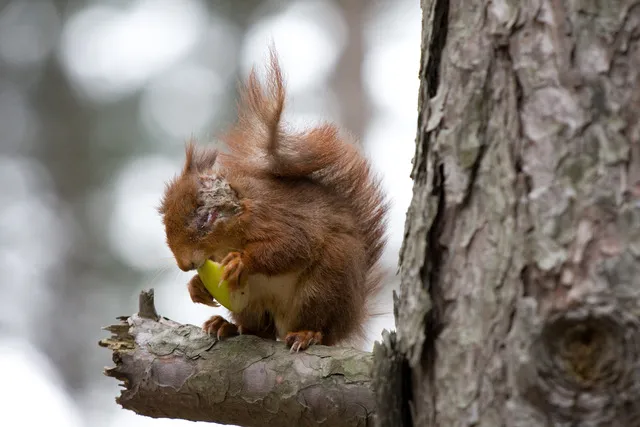What is squirrel pox?
Squirrel pox is a fatal, yet easily transmitted disease that affects red squirrels.
When did squirrel pox first arrive in the UK?
Squirrel pox virus (SQPV) is suspected to have been in the UK since at least 1900 with the first confirmed case in Norfolk in 1980. It is thought that the arrival of the grey squirrel heralded the beginning of the disease as there are no records of anything like it prior to their arrival.
Red squirrel deaths (presumed related to SQPV) have been noted as early as 1905, but strangely, some of these occurred in locations where there were no recorded grey squirrels.
In their native North America, greys suffer a similar infection to SQPV caused by a different viral agent and some have also been found to have antibodies to the UK disease too, supporting the theory that the virus arrived in Britain with American imports.
How deadly is squirrel pox?

Once a red squirrel has the disease, it is rare for it to survive. Symptoms are similar to that of a rabbit with myxomatosis – lethargy and panting. Swollen lesions appear around the mouth, nose, eyes, ears and genitalia with death normally occurring within 10-15 days.
How do red squirrels catch squirrel pox?
Studies relating to transmission have revealed clues but are inconclusive. From grey to red, parasites could be the most likely cause although other methods cannot be ruled out. Red to red, however, it is more likely to transfer via faeces, urine, saliva at feeders and contact through fighting, mating, etc.
For this reason, all volunteer conservation groups understand the need to remove supplemental feeders at the first suspicion of an outbreak, and not to put them back until it is clear. The same groups are encouraged to maintain feeders with an antiviral cleaning agent to help reduce the risk of the disease spreading.
What affect does squirrel pox have on red squirrel populations?
SQPV arrived in Formby in late 2007. The area had one of the largest remaining red squirrel populations in mainland England and was a significant attraction for tourism, wildlife enthusiasts and photographers.
By spring 2008, a survey suggested that the population was down by some 60 per cent and with a hard winter looming, later reviews arrived at an astonishing 80 per cent loss of the population. By 2013, a study completed by Liverpool University highlighted that the population was rebounding but precious few of the animals examined had antibodies to the virus. New outbreaks in 2018, and 2021 have continued to affect the area.
It is widely understood that the grey squirrel outcompetes the red in ideal habitat, and that it can take merely a few generations of interspecific competition to force the red to retreat into habitat that is unappetising to greys. When SQPV is present too, scientists suggest the disappearance of reds is accelerated 17 to 25 times the normal rate.
Man image © Getty

